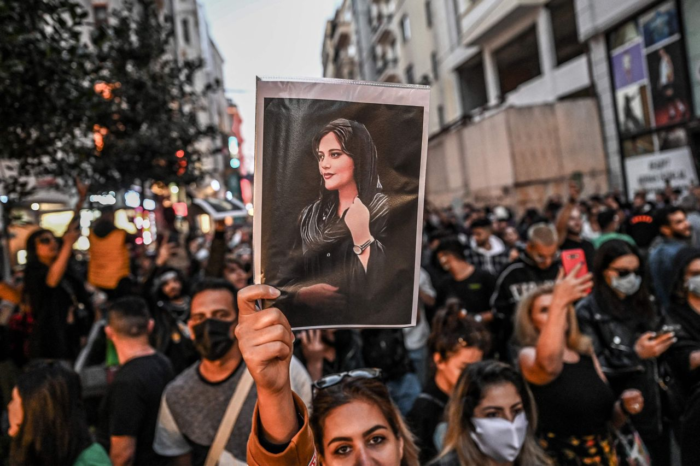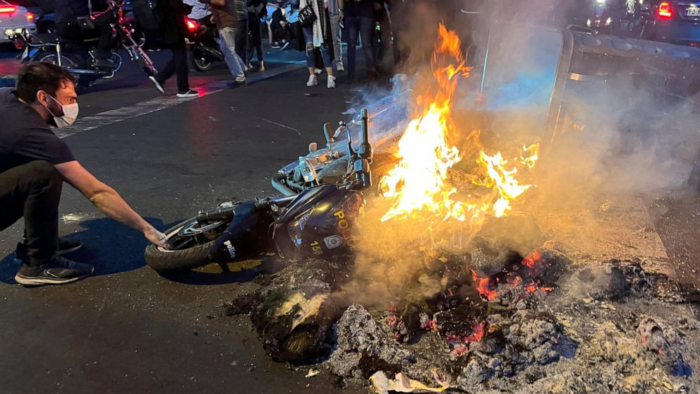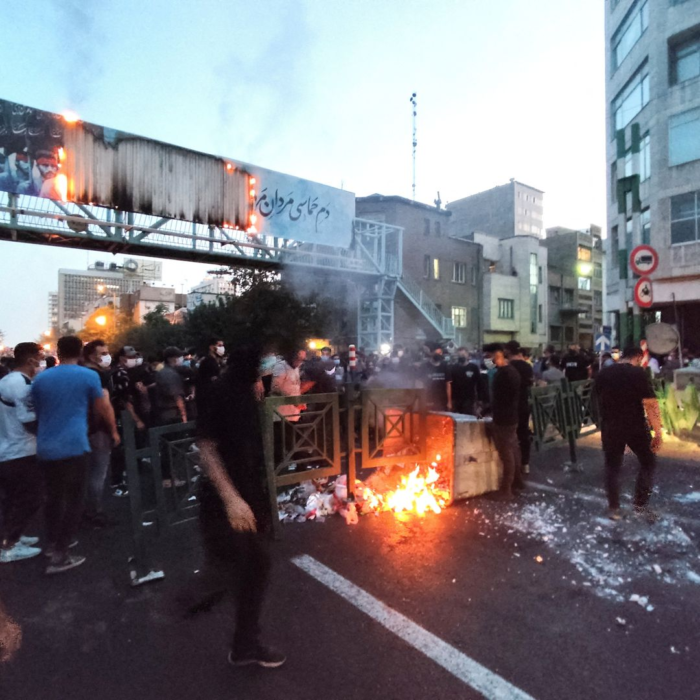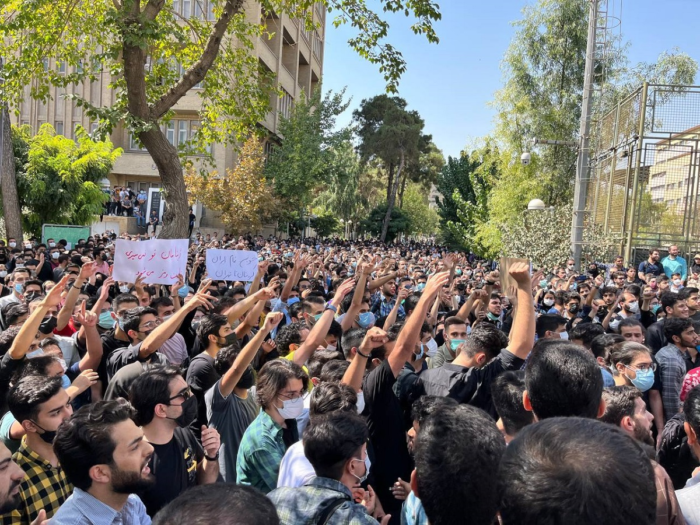Last month the Black Rose Anarchist Federation posted an interview with Iranian Anarchists on the growing revolt in response to police violence and state power in Iran. Recently our friends at the Bellingham Alternative Library formatted that interview into a beautiful zine, and we are hosting it here for further dissemination.
Please download and print to your hearts’ content. Full text of the interview below
On September 13th, 2022, 22 year old Mahsa Amini was arrested by an Iranian Guidance Patrol (also known as ‘morality police’). Mahsa was arrested in Tehran for not abiding by laws relating to dress. Three days later, on September 16th, police informed Mahsa’s family that she had “experienced heart failure” and had fallen into a coma for two days before passing away.
Eyewitness accounts, including that of her own brother, make clear that she was brutally beaten during her arrest. Leaked medical scans indicate that she had experienced a brain hemorrhage and stroke—trauma induced injuries which ultimately led to her death.
In the days since these details were revealed publicly, mass demonstrations have broken out across Iran decrying Mahsa’s murder at the hands of the police.
To better understand this rapidly changing situation, we conducted a very brief interview with the Federation of Anarchism Era, an organization with sections in Iran and Afghanistan.
This interview was conducted between the dates of 9/20/22 and 9/23/22.
Interview
Black Rose / Rosa Negra (BRRN): First, please give a brief description of the Anarchist Federation of Era.
Federation of Anarchism Era (FAE): The Federation of Anarchism Era is a local anarchist federation active in so-called Iran, Afghanistan, and beyond.
Our federation is based on the Synthesis Anarchism, accepting all anarchist tendencies except nationalist, religious, capitalist, and pacifist tendencies. Our many years of organizing experience within extremely oppressive environments like Iran have led us to develop and utilize insurrectionist organizational tactics and philosophy.
We are an atheist organization, viewing religion as a hierarchical structure that is more ancient and enduring than almost all other authoritarian systems and much too similar to capitalism and other authoritarian social structures enslaving humanity today. Class warfare, from our perspective, includes warring against the clergy class who rob us of our freedom and self-autonomy by defining the sacred & taboo and enforcing them by coercion and violence.
BRRN: Who was Mahsa Amini? When, why, and how was she killed?
FAE: Mahsa Amini, know by her family as Zhina, was an ordinary 22-year-old Kurdish girl from the city of Saghez (Saqez) in Kurdistan.
She traveled with her family to Tehran to visit families. On September 13th, while with her brother, Kiaresh Amini, the morality police or the so-called “Guidance Patrol” arrested Mahsa for “improper hijab.” Her brother tried to resist the arrest, but the police used tear gas and beat Kiaresh as well.
Many other arrested women witnessed what happened in the police van. Along the way to the police station, there was an argument between detainee women and police officers. Mahsa Amini was one of the girls protesting their arrest. She was saying she was not from Tehran and should be let go.
The police used physical violence to shut all the detainee women up. Mahsa was beaten as well. The eyewitnesses said the police officers hit Mahsa’s head hard to the side of the police van.
She was still conscious when she arrived at Moral Security Agency, but the other detained women noticed that she looked unwell. The police were completely indifferent and accused her of acting. The women kept protesting to help Mahsa get the medical attention she needed. The protests were met with violence from the police. Mahsa Amini was beaten severely by police again and lost consciousness then.
Police then took notice and attempted to revive her by pumping her chest and raising and massaging her legs. After those attempts failed, the police attacked other women to confiscate all cellphones and cameras that may have recorded the incident.
After much delay and finding the lost keys to the ambulance, Mahsa was taken to Kasra Hospital.
The clinic which admitted Mahsa Amini claimed in an Instagram post that Mahsa was brain dead when she was admitted. That Instagram post was later deleted.
On September 14th, a Twitter account with a friend working in Kasra Hospital told the story that the police threatened the doctors, nurses, and staff not to take any pictures or video evidence and to lie to Mahsa’s parents about the cause of the death. The hospital, being intimidated, complied with the police. They lied to the parents that she was in an “accident” and kept her on life-support for two days. Mahsa was declared dead on September 16th. Her cause of death from the medical scans, leaked by hacktivists, shows bone fractures, hemorrhage, and brain edema.

BRRN: Did Mahsa’s identity as a Kurd play a role in her arrest and death?
FAE: Undoubtedly, being a Kurd in Tehran played a role in Mahsa’s eventual death. But, this is a reality all women in Iran experience. We don’t need to look far to find video footage of the morality police beating and forcing women into police vans, throwing women out on the street from a moving car, and being harassed by Hijabi women for their “improper hijab.” Those videos show just a tiny fraction of the hell women experience in Iran.
Mahsa being with her brother on the day of her arrest was not random happenstance. In Iran’s patriarchal society, women should bring a male relative, whether a father, husband, brother, or cousin, along with on their business to ward off the morality police and discourage any surly individuals in public. Young couples can’t be seen too close to each other in public or risk being beaten and arrested by the morality police. Relatives needed to have documents as proof of their claims to the police. Arresting women for lipsticks and nail polish was a reality many of us millennials in Iran remember vividly.
The threat of acid attacks for “bad hijab” is another nightmare women endure in Iran.
Patriarchy and religious autocracy affect all women.
BRRN: How did the Iranian people learn of Mahsa’s death? What was the initial popular response?
FAE: As we elaborated earlier, there were too many eyewitnesses. No amount of threats could have stopped the story of Mahsa’s death from leaking.
It is worth mentioning the doctor attending Mahsa and the photojournalist documenting Mahsa’s condition and her family in distress, were both arrested, and their current status is unknown.
The initial response was outrage. People were already sharing Mahsa’s story from September 14th. The outrage was not yet strong enough for protests and revolts. People still thought Mahsa was in a coma, and there was hope for her recovery. Then, She was declared dead on September 16th.
First, there were small protests at Kasra Hospital, which were scattered by the police. The sparks of the current uprising were lit in Saghez, Mahsa’s hometown.

BRRN: What is the scale of the current demonstrations? In what areas of the country have the demonstrations been concentrated?
The situation is very dynamic and changing exceptionally rapidly. At the time of writing this, the flames of the uprising have set 29 out of 31 provinces of Iran on fire. One of the characteristics of this uprising is that it spread to major cities across Iran, such as Tehran, Tabriz, Isfahan, Ahvaz, Rasht, and others fast.
Qom and Mashhad, the ideological strongholds of the regime, have joined the uprising. Kish island, the capitalist and commerce center of the regime, has also revolted. This is the most diverse uprising we have witnessed in the last few years.
On September 23rd, the syndicalists are planning a general strike in favor of the protests.
The regime has an armed demonstration planned on the same day. A lot is happening.
BRRN: How has the Iranian state responded to these demonstrations?
The regime’s initial response was less brutal than we experienced before. One reason is that they got caught off-guard. They didn’t expect this strong response. The more important reason is that Ibrahim Raisi is at the UN. The lack of senior authority figures, publicized story of Mahsa and protests, and the pressure on the government being watched by the international community have stopped the massacre for now.
Don’t get us wrong. Police killed and injured many people from day one of the protests. Some among them were 10 years old children and 15 years old teenagers. But, we experienced November 2019 when the regime massacred many thousands of people in 3 days.
In all the previous uprisings, the police were not directly the target of the ire of people. Not this time. They are the baddie this time, and people are out for their blood. This wears them down physically and mentally, which we take as good news.
Right now, Saghez and Sanandaj are experiencing ruthless suppression. The regime has brought tanks and heavy military vehicles to suppress the uprising there. There are many reports of live ammunition being shot at protestors.
The protests are still going. The police cars are being flipped. The police stations were scaled and burned down. We just need to arm ourselves by looting their armory. Then, we enter another phase of revolt altogether.

BRRN: Is it accurate to call these demonstrations feminist in character?
FAE: Yes, Absolutely. Like all other uprisings, there were developments and movements beneath the surface.
It can be said that the recent crackdown on the Hijab and increased brutality of the morality police started in response to Iranian women’s spontaneous, autonomous, and feminist self-organization. Earlier this year, women in Iran began to black-list and boycott people and businesses, such as cafes, that strictly enforce the Hijab. The movement was decentralized and leaderless, aimed at creating safe spaces for women and members of the LGBTQ community.
That brutal oppression culminated at this moment where women are at the forefront everywhere, burning their scarves and beating down cops without Hijab. The main slogan of the uprising is also “Woman, Life, Freedom,” a slogan from Rojava, a society whose ambitions are based on anarchist, feminist, and secular ideology.
BRRN: What political elements (organizations, parties, groups) are present in the demonstrations, if any?
FAE: Many organizations, parties, and groups attempt to appropriate or influence the protests for their benefit at every uprising.
The majority of them ran into an unscalable problem during this uprising.
First, The monarchists. Reza Pahlavi, the deadbeat son of so very dead previous Shah of Iran, an individual being propped up by stolen money and media networks outside Iran, called for a national day of mourning amidst public outrage and initial protests instead of using his resources to assist the revolt. People finally saw him for the charlatan that he is. “Death to oppressors, whether Shah or Leader,” was heard all across Iran.
Then, MEK or Mujahedin Kalq. MEK has an ideological problem with this uprising. They are a cult whose women members are forced to wear red scarves. Their origin story is from combining Marxist and Islamic ideologies, hijacked by Marxist-Leninists before 1979, to the cult in service of capitalist and imperialist states today. Yet, the women in Iran are burning their headscarves and Quran. They have no say in this political climate.
Then, there are communist parties who despise Rojava and always speak ill of it. Their debunked and rusty class analysis doesn’t help them win hearts here.
With all their talks and propaganda of being proponents of secularism and feminism, they didn’t even have one slogan geared toward women’s liberation. And their ideology prevented them from chanting “Women, Life, Freedom.” They had nothing to say, so they shut up. Thanks to that, their presence is much weaker in the protests today.
The Anarchist movement is growing in Iran. This uprising, being leaderless, feminist, anti-authoritarianism, and chanting Rojava slogans, led to anarchists, affiliated and unaffiliated with the federation, having a strong presence in this uprising. Unfortunately, many have been arrested and injured as well.
We are working to realize the anticapitalist potential of this movement. Because the Islamic Republic is a death cult and religion, patriarchy, racism, and capitalism are its ideological pillars. For us to live, we need to be free; and that can’t be done without women’s liberation at the forefront.

BRRN: In solidarity. Thank you for your time.
FAE: Solidarity.
Recent Comments